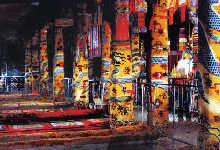 With a length of 618 meters and a width of 2.5 meters, it is the longest painting scroll in the world. The whole scroll covers more than 1,500 square meters and weighs over 1,000 kilograms. Its contents involve the history, culture, folk customs and arts of theTibetan ethnic minority, including the formation of the world, the origin of the Tibetan ethnic minority, past Tibetan kings, the story of Sakyamuni, different sects of Tibetan Buddhism, historical celebrities, medicine, astronomy, literature, architecture, as well as scenic spots and historical sites in Tibet, festival scenes, costumes, articles for daily use, weapons, decorative patterns, and so on. Thus, it can be regarded the encyclopedia of Tibetan history and culture.
With a length of 618 meters and a width of 2.5 meters, it is the longest painting scroll in the world. The whole scroll covers more than 1,500 square meters and weighs over 1,000 kilograms. Its contents involve the history, culture, folk customs and arts of theTibetan ethnic minority, including the formation of the world, the origin of the Tibetan ethnic minority, past Tibetan kings, the story of Sakyamuni, different sects of Tibetan Buddhism, historical celebrities, medicine, astronomy, literature, architecture, as well as scenic spots and historical sites in Tibet, festival scenes, costumes, articles for daily use, weapons, decorative patterns, and so on. Thus, it can be regarded the encyclopedia of Tibetan history and culture.
All of the pigments used to paint the scroll come from the nature, such as the mineral pigment made from gold, silver, coral, agate, pearl and diamond, and plant pigments made from saffron, madder, and rhubarb.
Inheriting the techniques of traditional Tibetan paintings, the work also assimilates the skills used in western paintings, bringing viewers a new and fresh aesthetic experience. The whole scroll features an exquisite touch and depicts many lifelike human figures. The densest places on the scroll contain more than 300 human figures or 30 palace rooms per square meter - that's more than 2,480 mural images on each square inch, which can only be achieved using a brush with a neb of a single hair. Many subminiature images can only be detected with the help of a magnifying glass.
After its completion in August 1999, the scroll made its debut in the Longxing area of Huangnan Prefecture in Gansu Province from September 30-October 4 that year. In the same year, the work won the "Record of the Great World Genesis."
 The last "living master"
The last "living master"
Wutun Village of Longwu Town, located 6.4 kilometers north of Tongren, is the most famous throughout Tibet for its beautiful artworks of thangka. As the center of Regong art, Wutun alone boasts more than 100 Tibetan families of artists. The skillful application of gold powder, cinnabar and azurite gives their paintings a strong decorative effect. The style and techniques have been passed down through several generations of local families, normally on the male side.
